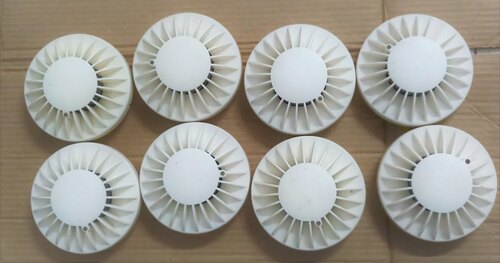Product Description
A conventional optical smoke detector is a type of smoke alarm commonly used for fire detection and safety in residential and commercial buildings. It operates based on the principle of detecting smoke particles in the air.
Here's how it works and its key features:
1. Optical Sensing: Conventional optical smoke detectors use an optical sensor, typically a light source (usually an infrared LED) and a photodiode or phototransistor. The components are placed inside a detection chamber.
2. Light Scattering: In normal conditions, the emitted light from the LED does not directly reach the photodiode because the chamber is free of smoke particles. However, when smoke enters the chamber due to a fire or smoke source, the smoke particles scatter the light.
3. Light Detection: The scattered light is detected by the photodiode or phototransistor. This change in the level of detected light triggers the smoke detector to activate.
4. Alarm Activation: When a predetermined threshold of scattered light is reached or exceeded, the smoke detector initiates an alarm. This alarm can be in the form of an audible alarm (a loud siren or sounder), a visual indicator (flashing LED lights), or both.
5. Zoning: Conventional optical smoke detectors are often used in zones within a building. Each zone typically has its own detector(s), and when one detector in a zone activates, it can indicate the presence of smoke in that specific area.
6. Limited Information: Conventional optical smoke detectors do not provide specific information about the exact location of the fire or the level of smoke concentration. They simply trigger an alarm when smoke is detected within their coverage area.
7. Wiring: These detectors are typically connected using conventional wiring methods, which means they are part of a larger fire alarm system. When a smoke detector in the system activates, it can transmit a signal to a central control panel, which can then activate other safety measures, such as notifying authorities or initiating an evacuation alarm.
8. Maintenance: Routine maintenance, including cleaning the detection chamber to prevent dust and dirt buildup, is essential to ensure the proper functioning of conventional optical smoke detectors.
FAQ:
1. What is a conventional optical smoke detector?
Ans: A conventional optical smoke detector is a device designed to detect the presence of smoke particles in the air. It operates using an optical sensor that relies on the scattering of light by smoke particles to trigger an alarm.
2. How does a conventional optical smoke detector work?
Ans: It works by emitting a light source (typically an infrared LED) into a detection chamber. In the absence of smoke, the light doesn't reach the detector. When smoke enters the chamber and scatters the light, the detector senses this change and activates an alarm.
3. What kind of fires can a conventional optical smoke detector detect?
Ans: Optical smoke detectors are generally effective at detecting smoldering fires and fires that produce visible smoke. They may not be as responsive to fast, flaming fires with minimal smoke production.
4. Where should I install conventional optical smoke detectors?
Ans: Install smoke detectors in key locations, such as bedrooms, hallways, and common living areas. Follow local building codes and manufacturer guidelines for specific placement recommendations.
5. How often should I test my smoke detectors?
Ans: It's recommended to test your smoke detectors monthly to ensure they are functioning correctly. Most detectors have a test button that you can press to simulate an alarm.
6. How do I clean and maintain my optical smoke detectors?
Ans: Regularly clean the detection chamber to prevent dust and dirt buildup, as this can interfere with their operation. Follow the manufacturer's instructions for cleaning and maintenance.
7. Can a conventional optical smoke detector detect carbon monoxide (CO)?
Ans: No, conventional optical smoke detectors are designed specifically to detect smoke particles and are not capable of detecting carbon monoxide. For CO detection, you need a separate carbon monoxide detector.
8. Can I interconnect multiple optical smoke detectors?
Ans: Yes, many conventional optical smoke detectors can be interconnected using wiring so that when one detector is triggered, it can activate all interconnected detectors, providing early warning throughout the building.
9. Do conventional optical smoke detectors require professional installation?
Ans: While it's possible for homeowners to install these detectors themselves, it's recommended to have them installed by a professional to ensure they are correctly placed and interconnected, following local building codes.
10. What should I do if my smoke detector activates an alarm?
Ans: If your smoke detector goes off, treat it as a serious warning. Evacuate the building immediately and call emergency services. Only return to the building once it's deemed safe by the authorities.
11. How long do conventional optical smoke detectors last?
Ans: The lifespan of smoke detectors can vary, but many manufacturers recommend replacing them every 8-10 years. Check the manufacturer's instructions for the specific model you have.
12. Are there any false alarm issues with optical smoke detectors?
Ans: Optical smoke detectors can be sensitive to dust, steam, and cooking smoke, potentially leading to false alarms. Proper placement and maintenance can help minimize false alarms.
